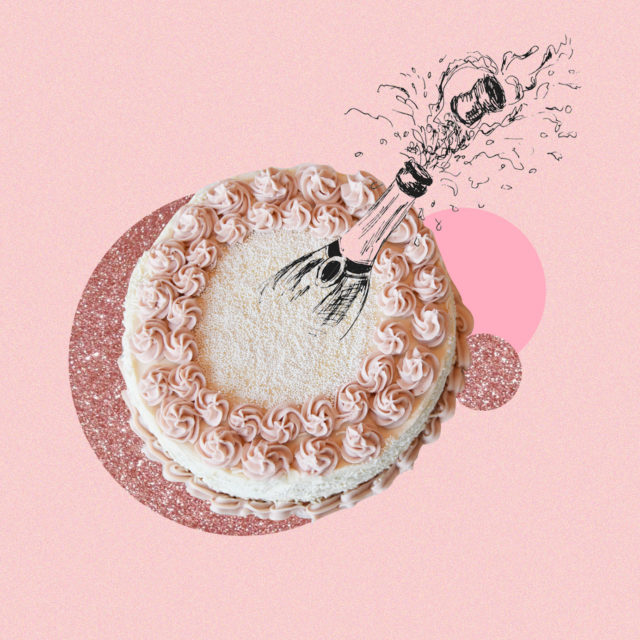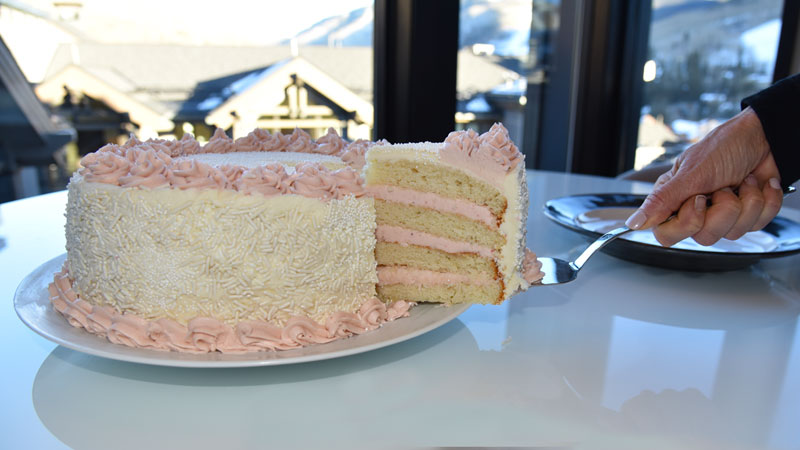When we think of New Year’s Eve, a few key images pop into mind: “Dick Clark’s New Year’s Rockin’ Eve,” the annual countdown, fireworks, and, of course, Champagne. Champagne is to New Year’s Eve what turkey is to Thanksgiving: The holiday simply would not be the same without it.
For those looking for an extra sweet New Year, consider the Champagne cake, an unheralded dessert that’s pretty enough to be your NYE table centerpiece, and delicious enough to be enjoyed throughout the year for occasions big and small.
Lisa Mansour, director and founder of NY Cake Academy, says that Champagne came into fashion in the ‘50s and ‘60s, when pop culture was all about Hollywood glamour. As it was rumored that Princess Margaret was an avid pink Champagne drinker, the beverage became ultra chic in Tinseltown and beyond. “You were in vogue if you had anything ‘pink Champagne,’” Mansour says, with the trend influencing everything from cakes to Marilyn Monroe’s outfits.
Champagne cakes are typically white layer cakes with pink frosting. However, some recipes call for both pink cake layers and pink icing. Back in the day, Champagne cakes were dyed flamingo pink, but today, they are typically a lighter, blush color. And while Terri Lee Stone, co-author of “Booze Cakes,” describes traditional Champagne cake as “white cake layered with rum, Bavarian or whipped cream filling, pink buttercream icing — and not an ounce of Champagne,” most modern interpretations of the cake do, in fact, include a splash of the festive bubbly.
Some recipes call for cooked and cooled Champagne, while others, like Stone’s, simply use bubbly straight from the bottle. This creates a sweet, slightly acidic flavor that pairs well with glasses of sparkling and midnight smooches.
Mansour says the only time you may want to heat your Champagne is when using it in your frosting. “When you cook it down, it’s actually going to intensify the flavor,” she says. Reducing the bubbly therefore allows you to infuse the flavor of Champagne into your frosting without affecting its consistency.
Not sure you want to bake with your fanciest Champagne? Stone says any sparkling wine will do, though using Prosecco or Cava may slightly affect the flavor of the cake. However, while less expensive sparkling wines make for suitable substitutions, Stone’s motto is, “Never bake with anything you wouldn’t drink.” As her recipe calls for just a cup or two of Champagne, “You’re gonna want to drink the rest of the bottle,” she says.
While Champagne’s carbonation doesn’t affect the cake’s texture or flavor, the sparkling wine’s acidity does. “What acid does to a recipe, specifically cake batter, is that it makes it very soft in texture and gives it a desirable crumb,” Mansour says. “It even enhances flavor.” This acidity gives Champagne cake its light and airy feel. If you don’t have bubbly on hand, Mansour says that still white wines or rosés can work as substitutions.
If you, like Stone, consider Champagne cake to be a combination of your two “favorite food groups,” try out the recipe below and wow your pod on New Year’s Eve. The only rule, Mansour says, “You have to have Champagne with this cake.”
Pink Champagne Cake Recipe (from “Booze Cakes” by Terri Lee Stone and Krystina Castella)
Pink Champagne Cake
3 cups all-purpose flour
3 teaspoons baking powder
½ teaspoon salt
1 cup (2 sticks) unsalted butter
2 cups sugar
1 teaspoon vanilla extract
6 egg whites
A few drops red food coloring
⅔-2 cups Champagne
Pink Champagne Frosting
¾ cup (1½ sticks) unsalted butter
4 cups confectioners’ sugar
½ cup Champagne
¼ cup whole milk
1 tablespoon vanilla extract
A few drops red food coloring
Method:
1. Preheat oven to 350°F. Grease and flour two 9-inch round cake pans.
2. In a bowl, combine flour, baking powder, and salt; set aside. In a mixing bowl, beat butter and sugar 3 to 5 minutes, or until light and fluffy. Add vanilla and beat in egg whites one at a time.
3. Mix in food coloring. Beat in flour mixture and Champagne in three alternating additions, starting and ending with flour to prevent curdling. Pour batter into pans and bake for 35 minutes, or until a knife inserted in the center comes out clean.
4. For the frosting: In a mixing bowl, beat butter 1 minute. Gradually add the confectioners’ sugar, Champagne, milk, vanilla, and food coloring; beat until smooth and creamy.

